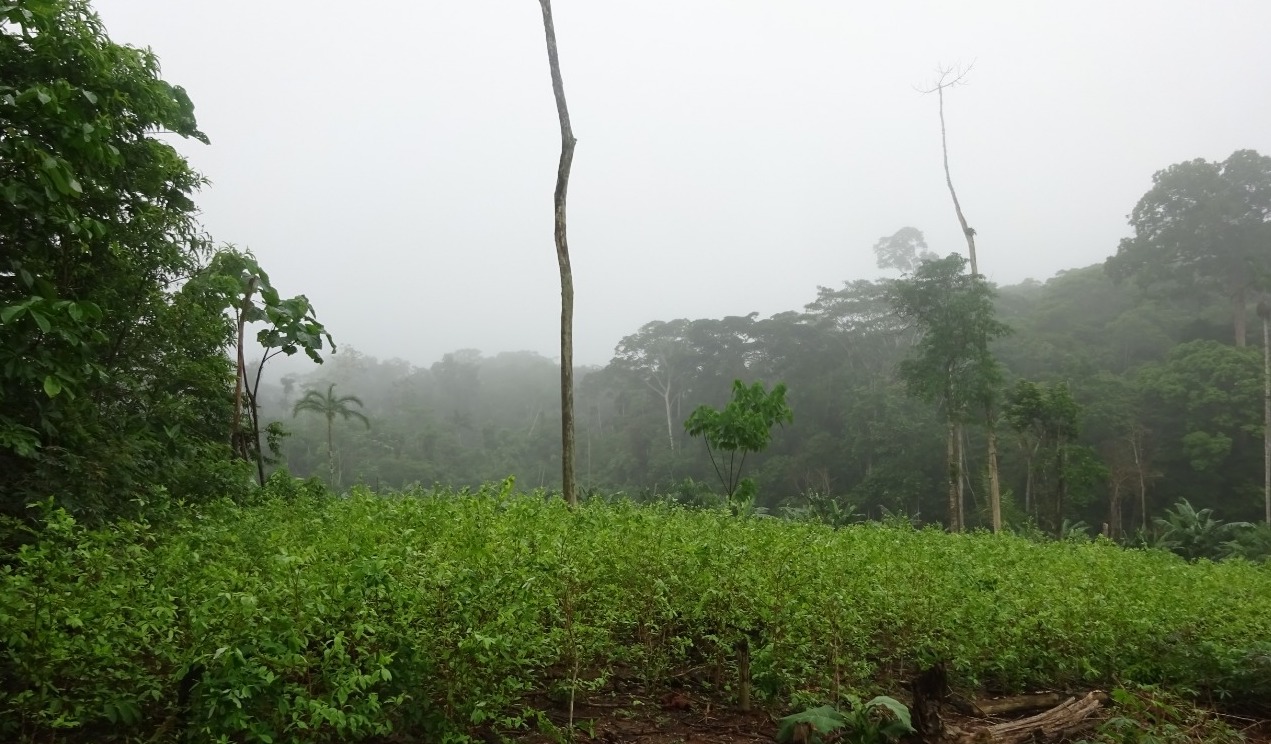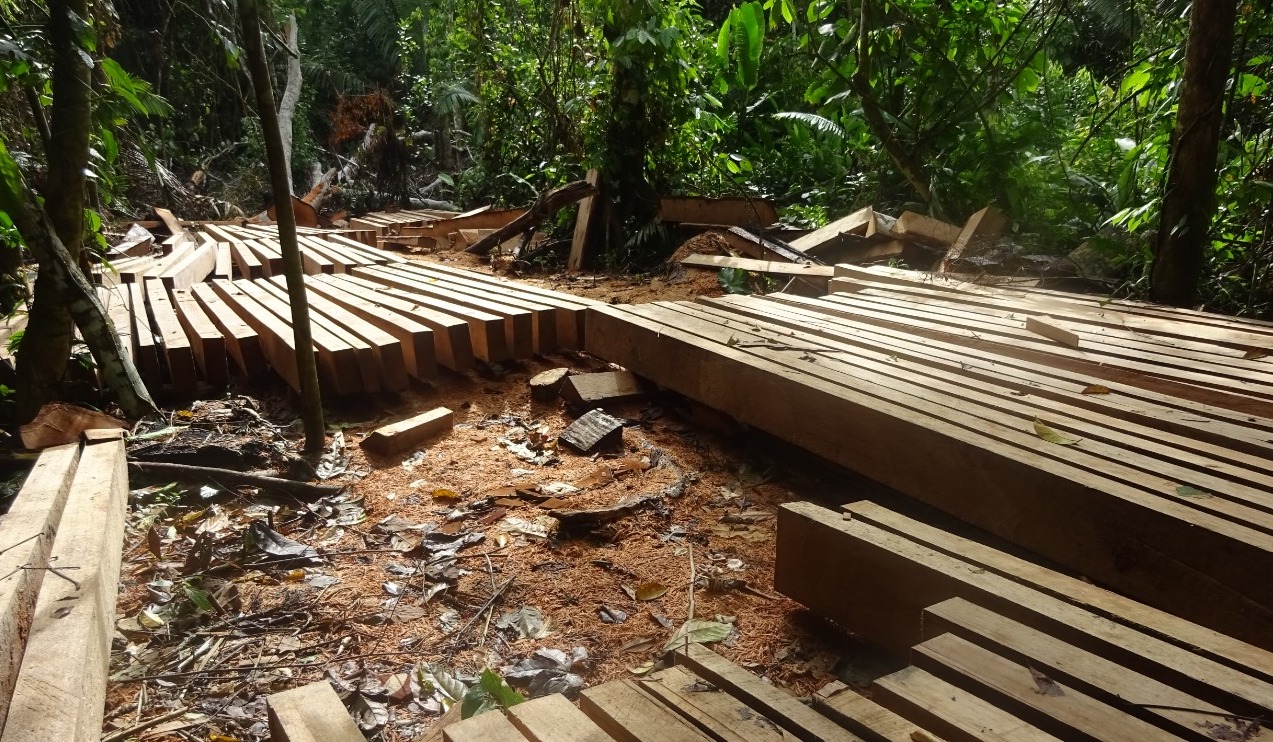- Indigenous Kichwa communities in northern Peru say outsiders are illegally invading their land and cutting down rainforest to plant coca and sell timber. Coca is used to make cocaine.
- Sources say Kichwa communities are struggling to gain land titles for their territory and have experienced confrontations with outsiders that include threats to their leaders, and have requested state intervention.
- Regional authorities say they cannot intervene in the area because they do not have the necessary security force to contend with armed criminal groups in the area.
A group of Kichwa patrollers living in the Peruvian Indigenous communities of Santa Rosillo de Yanayaku and Anak Kurutuyaku made an unexpected discovery in 2018. On their land in the Lower Huallaga region, they found coca cultivated in areas that did not correspond to communities’ traditional use of the plant.
Coca is used to make cocaine, and community members say it is compounding the list of threats to their territory, which already included logging and illegal colonization by outsiders.
“We don’t know what else to do! We see how the Amazon’s forests are helplessly disappearing and our lives are in danger for defending them,” said a Kichwa community member who asked to remain anonymous for safety reasons.
Sources say Kichwa (also spelled “Kechwa”) communities are struggling to gain land titles for their territory and have experienced confrontations with outsiders that include threats to their leaders, and have requested state intervention.

In 2019, Peru’s National Commission for Development and Life without Drugs (DEVIDA) confirmed unsanctioned coca cultivation in areas near Cordillera Azul National Park. The area is located in the district of Huimbayoc, which also includes the communities of Santa Rosillo de Yanayaku and Anak Kurutuyaku. According to Kichwa leader Marisol García Apagueño, secretary of the Federation of Indigenous Kechua Chazuta Amazonian Peoples (FEPIKECHA), the amount of area under coca cultivation has increased during the COVID-19 pandemic.
The Kichwa live in the Amazon region of San Martín and are recognized as an Indigenous group by Peru’s Ministry of Culture. Agriculture, hunting and handicrafts are their traditional practices. Wilger Apagueño, president of FEPIKECHA, said that despite official recognition as an Indigenous group that has inhabited the area for generations, the Kichwa have been unable to obtain formal ownership of the land on which they depend. He said that without legal recourse, the Kichwa have been unable to stop incursions by outsiders.
“Santa Rosillo de Yanayaku and Anak Kurutuyaku communities do not have land titles and are at risk due to the arrival of drug traffickers and loggers [into the area],” Wilger Apagueño said.

Coca is an attractive crop in areas that are economically depressed and where residents have few other viable prospects. According to DEVIDA, the price of coca leaf in San Martín in April 2021 was around $2 (7.5 soles) per kilogram, compared to $0.60 (2.5 soles) for cocoa, one of the primary legal crops grown in the region.
Santa Rosillo de Yanayaku community members report finding cleared land and downed trees that had been logged and hewn for transportation in addition to coca fields.
“We’ve carried out patrols and identified a number of ancient trees cut down by illegal loggers. We found 8,000 feet of wood and the authorities intervened,” said one Kichwa community member who preferred to remain anonymous. “After our complaints we were told that the State owns these lands – that it was not up to the community to complain, but we continue fighting, we aren’t going to remain silent.”
Among the tree species sought by loggers are lupuna (Chorisia integrifolia), aguanillo (Otoba parvifolia, O. glycycarpa), misho (Helicostylis tomentosa), mari mari (Vatairea guianensis) and caupuri (Virola pavonis), along with many others that are targeted for their high-value timber. Wilger Apagueño said these trees are ecologically important, and that removing them damages the surrounding forest.
In 2020, Indigenous community leaders filed a complaint with the Alto Amazonas Specialized Prosecutor’s Office for Environmental Matters (FEMA) in Yurimaguas. The prosecutor’s office responded that it did not have the resources necessary to intervene in such a high-conflict area and that it would require police support to do so. As of the date this story was published, FEMA has not obtained the security detail required to assist in the region.

Illegal activities continue in the meantime, according to Kichwa community members who said that they discovered a clandestine airstrip earlier this year that raised concerns that it may be used to traffic drugs out of the area.
“We know that if we talk, we or our families could become victims,” said one man who reportedly was forced to leave his home and prefers not to be identified for safety reasons.

William Ríos, the official in charge of the Land Titling, Reversion and Registry Department of the Regional Government of San Martín said that there is hostility among the community members and disagreement about how the land should be titled.
“Some want it to be a native community, a collective titling, while others ask for individual titling,” Ríos said. “As long as this conflict is not resolved, the regional government can’t move the process forward.”
Wilger Apagueño said this divisiveness within and between communities is aggravated by outside settlers who oppose collective titling and want the land to be split into plots that can be leased to drug traffickers.
In May 2021, a group of specialists from the NGO Forest Peoples Programme arrived in Anak Kurutuyaku, where they noted illegal coca crops near the community.

“The first thing that has been done is to cut down the trees, to deforest on a massive scale, so that when they have cleared the land they can begin to plant coca,” said one community member who wished to remain anonymous.
In 2019, with the help of an attorney, Anak Kurutuyaku leaders filed a complaint with the Alto Amazonas FEMA in Yurimaguas about the land invasions and deforestation caused by settlers. An inspection of the area was scheduled for 2020, though this could not go ahead due to the COVID-19 pandemic and quarantine restrictions implemented by the Peruvian government. At present, no date has set for an inspection.

Complicating the situation is that the local government reportedly does not recognize Anak Kurutuyaku as an Indigenous community because its residents speak Spanish instead of a native language. Santiago Tamay, coordinator of the branch of the Ombudsperson’s Office in Tarapoto, said Geyner Silva Macedo, mayor of Huimbayoc, has attempted to evict Indigenous Kichwa from Anak Kurutuyaku.
“We had to intervene with a delegation to prevent the conflict from escalating,” Tamay said. “It was explained to the mayor that he did not have the authority to recognize or not recognize a community – it was a very tense situation for the community.”
Geyner Silva Macedo refused to comment on the situation when contacted by Mongabay.
Meanwhile, residents of Anak Kurutuyaku said they fear the possibility of dangerous confrontation.
“What is going to happen to us without the support of the municipal or regional governments, or even the police? We are at greater risk every day,” said one Kichwa community member who asked to not be named for fear of reprisal.

Jorge Abrego Hinostroza, coordinator of Peru’s Ministry of Justice and Human Rights, said that protections have been enacted for human rights defenders in the Santa Rosillo community, and that they are in the process of being extended to Anak Kurutuyaku community members.
It is unclear what exactly these protections include, but Forest Peoples Programme advocacy coordinator Matias Pérez Ojeda del Arco said they are insufficient. He recommends the establishment of a police station in the district of Huimbayoc, as Kichwa residents currently must travel either six hours to Chazuta or a full day to Tarapoto to request protection or file complaints.
“They are completely isolated, we need the police and authorities to jointly intervene,” Perez said. “We know that this is a complex problem and that it can get worse.”
General José Ludeña Condori, director of the Environmental Police Directorate, said his office had not received information regarding deforestation complaints or associated illegal activities in the area. He added that they have noticed an uptick in illegal activity throughout the Colombian Amazon in general but that they require more logistical and budgetary support to carry out interventions.
In March 2021, Congressman Lenin Bazán facilitated a meeting between representatives of affected communities and the Ministry of Justice, Ministry of the Environment and Ministry of the Interior in Lima to discuss the incursions into Kichwa territory. However, FEPIKECHA secretary Marisol García Apagueño said there was no tangible outcome to the meeting.
“We can’t just wait for a tragedy to happen before action is taken,” García Apagueño said. “My community lives in fear because of the loggers, because of the drug trafficking that we know is destroying the forest that our ancestors took care of with so much effort.”
This story was reported by Mongabay’s Latam team and first published on our Latam site on July 12, 2021.
Banner image: Settlement near the Anak Kurutuyaku community. Image courtesy of anonymous source.
Editor’s note: This story was powered by Places to Watch, a Global Forest Watch (GFW) initiative designed to quickly identify concerning forest loss around the world and catalyze further investigation of these areas. Places to Watch draws on a combination of near-real-time satellite data, automated algorithms and field intelligence to identify new areas on a monthly basis. In partnership with Mongabay, GFW is supporting data-driven journalism by providing data and maps generated by Places to Watch. Mongabay maintains complete editorial independence over the stories reported using this data.
Feedback: Use this form to send a message to the editor of this post. If you want to post a public comment, you can do that at the bottom of the page.
